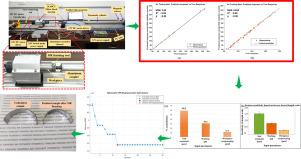利用机器学习算法优化中空圆柱表面磁流变精加工中预测表面粗糙度的工艺参数
IF 3
3区 材料科学
Q3 MATERIALS SCIENCE, MULTIDISCIPLINARY
引用次数: 0
摘要
在纳米精加工过程中实现高精度表面质量需要对工艺参数进行有效优化。这需要一个大的数据集,而实验是繁琐的,并且获得的实验数据是非线性的,并且包含异常值。因此,为了利用非线性实验数据有效地预测表面粗糙度,需要具有鲁棒性的预测技术。因此,本研究的重点是利用高斯过程回归(GPR)模型与贝叶斯优化相结合,对新开发的内圆柱面磁流变精加工工艺进行参数优化。GPR模型作为预测表面粗糙度的概率代理,具有极高的精度,R2 = 0.99,总体预测精度为99%。GPR模型对表面粗糙度的预测精度较高,均方根误差(RMSE)为3.3089,平均绝对误差(MAE)为2.6402,相对均方根误差(RRMSE)为0.0222。在测试阶段,该模型取得了最低的MSE(10.9487)、MAPE(1.84%)和最高的相关系数(CC = 99.49%),优于其他机器学习模型SVM、DNN和ANN,显示了其鲁棒性和泛化能力。采用贝叶斯优化方法,有效地搜索参数的最佳组合。,确定实现纳米级光洁度的最佳条件。通过K-fold交叉验证验证了GPR模型的鲁棒性和泛化能力。超参数优化进一步提高了模型的性能,减少了误差,实现了可靠的预测和超光滑表面的实现。当刀具转速为420 rpm,工作间隙为0.8 mm,往复速度为3 cm/s时,得到最佳结果。在这些条件下,内表面粗糙度急剧降低到令人印象深刻的Ra = 0.059μm。本文章由计算机程序翻译,如有差异,请以英文原文为准。

Optimization of process parameters for predicting surface roughness in the magnetorheological finishing of hollow cylindrical surfaces using a machine learning algorithm
Achieving high-precision surface quality in nano-finishing processes requires effective optimization of process parameters. This requires a large dataset for which experimentation is cumbersome, and the obtained experimental data is of a non-linear and contains outliers. Therefore, for effective prediction of surface roughness with non-linear experimental data, robust prediction techniques are required. Henceforth, this study focuses on optimizing parameters for the newly developed magnetorheological finishing process for internal cylindrical surfaces using a Gaussian Process Regression (GPR) model integrated with Bayesian optimization. The GPR model served as a probabilistic surrogate to predict surface roughness with exceptional accuracy, achieving an R2 = 0.99 and an overall prediction accuracy of 99%. The proposed GPR model achieved superior prediction accuracy for surface roughness, with a Root Mean Squared Error (RMSE) of 3.3089, a Mean Absolute Error (MAE) of 2.6402, and a Relative RMSE (RRMSE) of 0.0222. It outperformed other machine learning models, SVM, DNN, and ANN, by achieving the lowest MSE (10.9487), MAPE (1.84%), and highest correlation coefficient (CC = 99.49%) in the testing phase, demonstrating its robustness and generalization capability. Bayesian optimization was employed to effectively search for the best combination of parameters., identifying the optimal conditions for achieving a nano-level finish. The robustness and generalization capability of GPR model were verified through K-fold cross-validation. Hyperparameter optimization further enhanced the model’s performance, reducing errors, enabling reliable prediction and achievement of ultra-smooth surface. Optimal results were obtained with a tool rotational speed of 420 rpm, working gap of 0.8 mm, and reciprocating speed of 3 cm/s. Under these conditions, the internal surface roughness was drastically reduced to an impressive Ra = .
求助全文
通过发布文献求助,成功后即可免费获取论文全文。
去求助
来源期刊

Journal of Magnetism and Magnetic Materials
物理-材料科学:综合
CiteScore
5.30
自引率
11.10%
发文量
1149
审稿时长
59 days
期刊介绍:
The Journal of Magnetism and Magnetic Materials provides an important forum for the disclosure and discussion of original contributions covering the whole spectrum of topics, from basic magnetism to the technology and applications of magnetic materials. The journal encourages greater interaction between the basic and applied sub-disciplines of magnetism with comprehensive review articles, in addition to full-length contributions. In addition, other categories of contributions are welcome, including Critical Focused issues, Current Perspectives and Outreach to the General Public.
Main Categories:
Full-length articles:
Technically original research documents that report results of value to the communities that comprise the journal audience. The link between chemical, structural and microstructural properties on the one hand and magnetic properties on the other hand are encouraged.
In addition to general topics covering all areas of magnetism and magnetic materials, the full-length articles also include three sub-sections, focusing on Nanomagnetism, Spintronics and Applications.
The sub-section on Nanomagnetism contains articles on magnetic nanoparticles, nanowires, thin films, 2D materials and other nanoscale magnetic materials and their applications.
The sub-section on Spintronics contains articles on magnetoresistance, magnetoimpedance, magneto-optical phenomena, Micro-Electro-Mechanical Systems (MEMS), and other topics related to spin current control and magneto-transport phenomena. The sub-section on Applications display papers that focus on applications of magnetic materials. The applications need to show a connection to magnetism.
Review articles:
Review articles organize, clarify, and summarize existing major works in the areas covered by the Journal and provide comprehensive citations to the full spectrum of relevant literature.
 求助内容:
求助内容: 应助结果提醒方式:
应助结果提醒方式:


